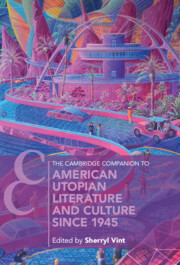Refine search
Actions for selected content:
112 results
Chapter 9 - Temporal Cycles and the Psychology of Time
- from Part II - The New Psychology of Intergroup Relations
-
- Book:
- The Psychology of System Change and Resistance to Change
- Published online:
- 23 September 2025
- Print publication:
- 09 October 2025, pp 185-200
-
- Chapter
- Export citation
Chapter 2 - Funding Utopia
-
- Book:
- Security, Fiscal Policy, and Sovereignty in Renaissance English Literature
- Published online:
- 04 September 2025
- Print publication:
- 18 September 2025, pp 32-57
-
- Chapter
- Export citation
Introduction
-
- Book:
- Zola's Dream
- Published online:
- 07 August 2025
- Print publication:
- 21 August 2025, pp 1-28
-
- Chapter
- Export citation
Chapter 19 - Avant-Gardist
- from Part III - Culture, Society, and Politics
-
-
- Book:
- María Irene Fornés In Context
- Published online:
- 27 August 2025
- Print publication:
- 07 August 2025, pp 205-215
-
- Chapter
- Export citation
Through the surrealist looking glass: international theory, imagination, and the Anthropocene
-
- Journal:
- International Theory , First View
- Published online by Cambridge University Press:
- 08 July 2025, pp. 1-23
-
- Article
-
- You have access
- Open access
- HTML
- Export citation
Chapter 19 - Cruising Utopia and the Queering of Latinx Literature
- from Part IV - Theoretical Turns
-
-
- Book:
- Latinx Literature in Transition, 1992–2020
- Published online:
- 19 June 2025
- Print publication:
- 03 July 2025, pp 352-366
-
- Chapter
- Export citation
Chapter 8 - Whiteness in Nineteenth-Century Speculative Writing
- from Part II - Whiteness in the American Literary Imagination
-
-
- Book:
- Whiteness and American Literature
- Published online:
- 19 June 2025
- Print publication:
- 03 July 2025, pp 121-134
-
- Chapter
- Export citation
Chapter 4 - White Nationalism
- from Part I - Whiteness and National Identity
-
-
- Book:
- Whiteness and American Literature
- Published online:
- 19 June 2025
- Print publication:
- 03 July 2025, pp 58-71
-
- Chapter
- Export citation
Chapter 8 - Empire, Nation, and the Question of Space
- from Part II - Developments
-
-
- Book:
- Space and Literary Studies
- Published online:
- 07 May 2025
- Print publication:
- 22 May 2025, pp 140-155
-
- Chapter
- Export citation
Chapter 18 - Imaginary Space
- from Part III - Applications and Extensions
-
-
- Book:
- Space and Literary Studies
- Published online:
- 07 May 2025
- Print publication:
- 22 May 2025, pp 303-318
-
- Chapter
- Export citation
Chapter 2 - Daedalus and Proteus
-
- Book:
- Satire, Instruction and Useful Knowledge in Eighteenth-Century Britain
- Published online:
- 24 April 2025
- Print publication:
- 08 May 2025, pp 29-50
-
- Chapter
-
- You have access
- Open access
- Export citation
Chapter 4 - Anthropologies of the Mechanical Arts
-
- Book:
- Satire, Instruction and Useful Knowledge in Eighteenth-Century Britain
- Published online:
- 24 April 2025
- Print publication:
- 08 May 2025, pp 84-108
-
- Chapter
-
- You have access
- Open access
- Export citation
4.7 - The New Person
- from History 4 - Heroes
-
-
- Book:
- The New Cambridge History of Russian Literature
- Published online:
- 31 December 2024
- Print publication:
- 12 December 2024, pp 788-805
-
- Chapter
- Export citation
Chapter 9 - The Expanded Theatre of the French Revolution
-
-
- Book:
- A New History of Theatre in France
- Published online:
- 22 October 2024
- Print publication:
- 21 November 2024, pp 183-205
-
- Chapter
- Export citation
Chapter 36 - The futures of International Relations
- from Part 4 - The new agenda: Globalisation and global challenges
-
-
- Book:
- An Introduction to International Relations
- Published online:
- 31 August 2024
- Print publication:
- 12 August 2024, pp 479-489
-
- Chapter
- Export citation
22 - The Gay Genre
- from Queer Genre
-
-
- Book:
- The Cambridge History of Queer American Literature
- Published online:
- 17 May 2024
- Print publication:
- 06 June 2024, pp 398-412
-
- Chapter
- Export citation
9 - Trans-ing Transcendentalism
- from Queer Literary Movements
-
-
- Book:
- The Cambridge History of Queer American Literature
- Published online:
- 17 May 2024
- Print publication:
- 06 June 2024, pp 173-191
-
- Chapter
- Export citation
Chapter 20 - Morris and Marxism
- from Part V - Influences and Legacies
-
-
- Book:
- The Cambridge Companion to William Morris
- Published online:
- 03 May 2024
- Print publication:
- 23 May 2024, pp 271-282
-
- Chapter
- Export citation
Chapter 1 - Oxford
- from Part I - Senses of Place
-
-
- Book:
- The Cambridge Companion to William Morris
- Published online:
- 03 May 2024
- Print publication:
- 23 May 2024, pp 15-26
-
- Chapter
- Export citation

The Cambridge Companion to American Utopian Literature and Culture since 1945
-
- Published online:
- 09 May 2024
- Print publication:
- 16 May 2024
